Hot summer days have arrived…
Are you and your passengers feeling hot and uncomfortable because your car’s AC is not blowing cold air? Does your air conditioner start cooling then stop, only work on high, or only work sometimes? You have air conditioning issues, but you’re not alone. Many car owners face AC issues, and it’s best to get them figured out before the days get even hotter!
Sometimes, the AC takes a second to get cold, especially if it’s a warmer than usual day. This is normal. However, if your car AC starts cooling then stops or constantly blows hot air, there are a variety of reasons why this may be happening and it’s likely a problem with one or more of the AC system’s components.
Before you start cursing your car’s broken AC, fear not.
If you’re experiencing problems with your car AC not blowing cold air, we have potential causes and DIY troubleshooting to share with you!
At Leo’s auto shop in Littleton, Colorado, we often have customers schedule appointments for issues with the flow and temperature of their car’s air conditioning. In general, your AC isn’t blowing cold air because of issues with one or more of the AC system’s user operations; electronics; refrigerant pressures, levels, or quality; or airflow.
Sound complicated? It can be, but we’ve talked to our experienced auto mechanics and narrowed down the list to 8 common reasons why your car AC is not blowing cold air.
If you want to skip ahead to the potential causes of car AC issues and DIY troubleshooting tips, click here on 8 Reasons Why Your Car AC Is Not Blowing Cold Air.
If you want to learn how your car’s AC system works so that you can better understand the technical reasons behind potential AC issues, keep reading.
How a Car Air Conditioning System Works
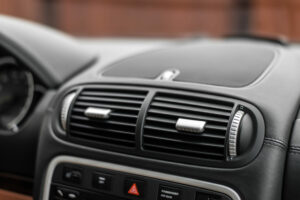
Firstly, let’s investigate the general idea of how air conditioning works. Understanding how a system works is important for troubleshooting any issues that may exist in the system. So, if you’re experiencing problems with your car AC not blowing cold air, all the components and how they work together will need to be assessed in order to determine the reason why your AC is acting up.
It’s important to know a little physics to understand your car’s ac system. Higher pressure is associated with higher temperatures and a gas state while low pressure is associated with lower temperatures and a liquid state. Additionally, cold air can be defined as air from which heat has been extracted or removed, and heat naturally tends to move towards areas with lower temperatures.
The AC system in your car is a cycle of components that cools the inside of your car through a series of steps that pressurize and depressurize a special liquid called refrigerant. When you turn on your car’s air conditioning, you’re telling the system of components to manipulate changes in pressure to make the refrigerant a lower temperature than the surrounding air. This way heat can be extracted and leave the air inside your car cold and refreshing.
If you want to skip ahead to the potential causes of car AC issues and their DIY troubleshooting tips, click here on 8 Reasons Why Your Car AC Is Not Blowing Cold Air.
If you want to dive a little deeper into how your car’s AC system and components work so that you can better understand the potential causes, keep reading.
Car AC Components
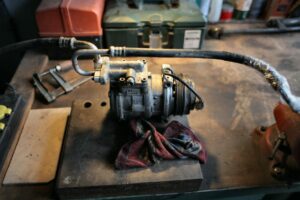
The cycle begins with the pressurization of refrigerant into a high-temperature gas by the workhorse of your AC system (the AC compressor). It seems counterintuitive that the AC system must first create a high temperature in order to reduce the temperature in your car, but this step is necessary to set the refrigerant and AC system in motion.
The high-temperature gas refrigerant travels to a radiator-like component (the AC condenser) at the front of your car’s engine bay where the refrigerant is converted into a liquid once enough heat is removed by a fan that blows air through the condenser’s metal fins.
Once a liquid, the refrigerant is filtered for chemical impurities through another component (receiver drier) and continues to the component near the inside of your car that makes the magic of AC happen (the expansion valve). The filtered liquid refrigerant’s pressure is greatly reduced by this component, which gives the refrigerant a much lower temperature than the surrounding air.
The low-temperature liquid refrigerant moves into another radiator-like component (the evaporator core) located behind your car’s dash vents.
Recall from earlier that cold air can be defined as air from which heat has been extracted, and heat tends to move towards areas with lower temperatures. Heat in the air is extracted from the air by the low-temperature refrigerant inside of the evaporator, and the resulting cold air is pushed through your car’s air vents by a blower motor fan, and voila! Your system blows cold air! The refrigerant returns to the condenser to restart the cycle that continues its cooling sequence as long as you have the AC turned on.
8 reasons why your car ac is not blowing cold air
If your car’s AC isn’t blowing cold air, keep reading for 8 common reasons why, DIY troubleshooting options, and overall recommendations for getting any AC problems resolved quickly.
As you read along to understand potential causes of auto AC issues, you should keep in mind:
- Modern cars can have confusing electronic controls
- Road debris, fender benders, and weather can damage components
- Every component has a lifespan
- Some AC problems require special equipment to diagnose or fix
- Symptoms can be similar or identical for different causes
- There may be multiple causes for your car AC not blowing cold air
1. User Error
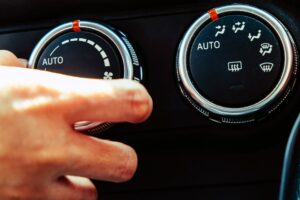
It’s possible to think that your car’s AC is broken when in fact you haven’t actually turned it on. This may be an issue if you recently purchased a new car and the buttons and settings are unfamiliar. If your car has digital climate controls and the AC doesn’t seem to be working right, ensure that the air conditioning system is activated (not just the fan) and that there aren’t any special climate programs running.
DIY Troubleshooting:
- Ensure that all of the air vents on your dash are open and not closed.
- If your car has an AC button, ensure that it is pressed and lit up to indicate that it is active.
- If your car has a max cool setting, ensure that it is pressed and lit up to indicate that it is active.
- If your car has dual climate zones, ensure that both the driver’s temperature control and the passenger’s temperature control are set to the same or similar temperatures.
- If it is hotter than usual out and the AC doesn’t instantly start working, give it a minute.
If none of these user error issues apply to your car’s AC problems or none of the steps helped fix your AC, move on to the next potential reason why your car’s AC isn’t blowing cold.
2. Dirty Cabin Air Filter
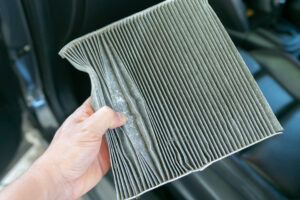
If your AC only works on the highest fan setting, you may not have an AC problem after all, and it could be a dirty cabin air filter! Your car has a filter that cleans the outside air before it travels through your air vents. Roads kick up plenty of dirt and debris that dirty the cabin air filter and restrict the flow of AC air from reaching you. When was the last time your car had an auto care & maintenance appointment where its cabin air filter was replaced?
DIY Troubleshooting:
- Locate your car’s cabin air filter, which is generally located behind the glove box or under the dashboard on the passenger side of the car. Take the filter out and inspect it for dirt, dust, and debris that could be restricting the flow of air and causing your car’s AC issues. Replace the filter if it looks dirty or clogged.
If a new cabin air filter didn’t improve the flow of cold air or your current filter is clean, move on to the next potential reason why your car’s AC isn’t blowing cold.
3. Electrical Issue
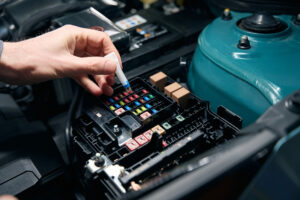
If your car AC doesn’t blow cold or has any other issues, your car may have an electrical issue. Your AC system depends on electrical signals that are sent from various buttons and components to sensors, through fuses, and finally to electrically activated components.
DIY Troubleshooting:
- Inspect your car’s climate control knobs and buttons for issues.
- Inspect your car’s fuse box for a blown fuse.
- Inspect under the hood for disconnected or damaged wiring. If you park your car outside, rabbits and rodents can easily find their way under your hood, and they enjoy nibbling on all sorts of connections.
If none of these issues apply to your car, move on to the next potential reason why your car’s AC isn’t blowing cold, or find a local auto repair shop to diagnose your car’s issue.
4. Refrigerant Leak
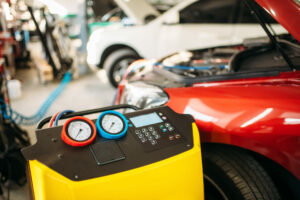
If your AC doesn’t work as well as it used to, you could have a refrigerant leak. If your car has a refrigerant leak, the refrigerant levels may be too low to function correctly. This results in poor cooling. Low refrigerant can be compared to trying to run a foot race without enough to drink. Some is helpful but may not be enough.
DIY Troubleshooting:
- Inspect each AC system component for corrosion or other damage that could allow a leak.
If you suspect that your AC system has a leak and is low on refrigerant, it’s best to have it checked by a certified AC repair shop. An experienced mechanic can safely and accurately locate AC leaks, repair any holes, and recharge the low-pressure side and high-pressure side with the correct amount of refrigerant.
5. Contaminated Refrigerant
Your AC may not blow as cold as it used to, and it could be caused by contaminated refrigerant. Moisture or impurities can find their way inside your AC system and compromise the refrigerant’s chemically engineered ability to keep you cool.
DIY Troubleshooting:
Flushing and replacing the refrigerant may resolve this issue, but a flush involves specialized tools and equipment. If you suspect that your AC problems are related to contaminated refrigerant, it’s best to have it checked by an auto shop certified to handle refrigerant.
6. AC Compressor Issues
If your car’s AC compressor has problems or has failed, it can result in a spectrum of AC problems. You may notice that your car AC isn’t blowing cold air, the AC starts cooling and then stops intermittently, or that it takes a ridiculously long time for the air to get cold.
DIY Troubleshooting:
- Open your hood and inspect the AC compressor belt for wear and damage.
- Listen for clicking and vibration to indicate compressor activation when you start your car’s AC.
- Listen for strange on-and-off AC compressor behaviors while your AC is on.
If you suspect that your AC system has a compressor issue, it is best to have a certified auto shop perform a diagnosis. A trained technician can accurately assess your car’s AC compressor and replace it if needed. Find a local auto repair shop to diagnose your car’s issue.
7. Damaged Condenser Fins
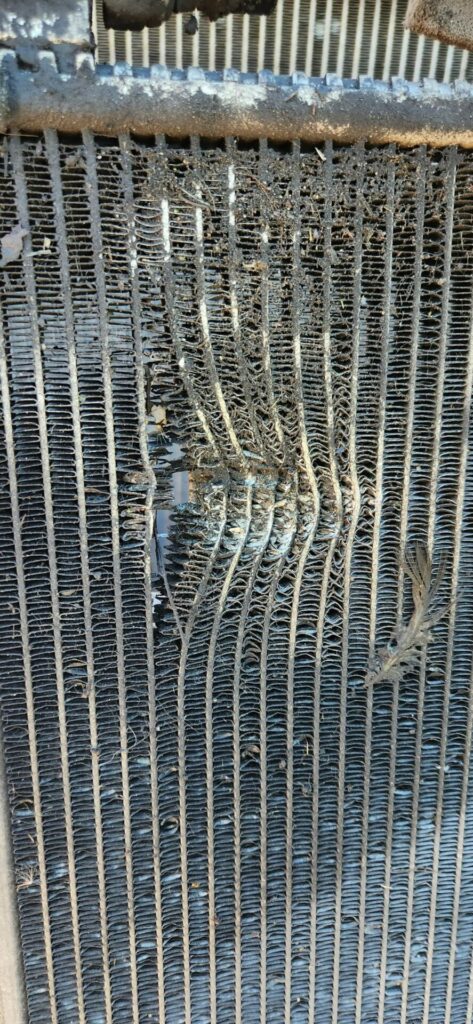
Your car’s AC problem could also be caused by poor airflow through the condenser’s fins. This radiator-like component relies on the flow of air through its fins. If the fins are damaged, it can reduce the efficiency of the system.
DIY Troubleshooting:
- Inspect the fins of the condenser for damage.
If you suspect that your AC system has a damaged condenser, it is best to have it inspected by a certified auto shop as soon as possible. A trained technician can accurately diagnose your car’s AC issue and repair any components using specialized tools and equipment. Find a local auto repair shop to diagnose your car’s issue.
8. Damaged Evaporator Fins
If your AC isn’t blowing cold air, you may have damaged evaporator core fins that are obstructing the flow of cool air into the car.
DIY Troubleshooting:
- Inspect the fins of the evaporator core for damage.
If you suspect that your AC system has a damaged evaporator core, it is best to have it inspected by a certified auto shop as soon as possible. A trained technician can accurately diagnose your car’s AC issue and repair any components using specialized tools and equipment. Find a local auto repair shop to diagnose your car’s issue.
Find AC Repair Services
If you’re experiencing AC issues with your car, it’s best to discuss your symptoms with an experienced auto shop to determine why your car’s AC isn’t blowing cold. Auto techs have a thorough understanding of the entire AC system and are quick to identify any issues using experience and specialized tools.
For most auto shops, you can schedule an independent diagnosis appointment or request that your mechanic inspect the issue during a routine maintenance appointment. Find a local auto repair shop to diagnose your car’s issue.
Get your car’s air conditioning fixed before the local weather heats up!


